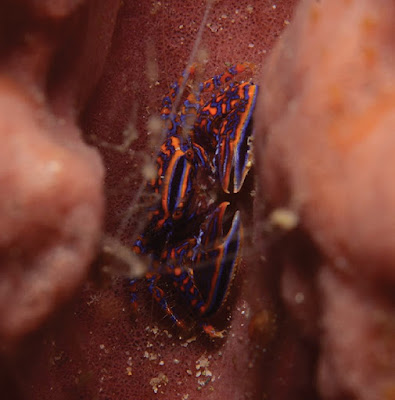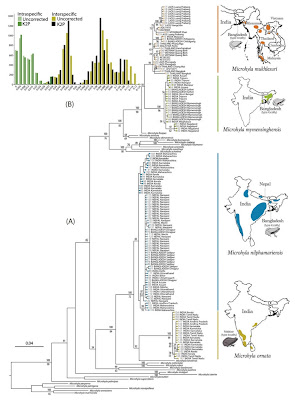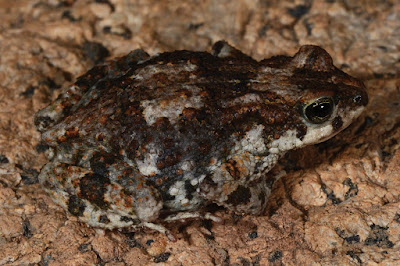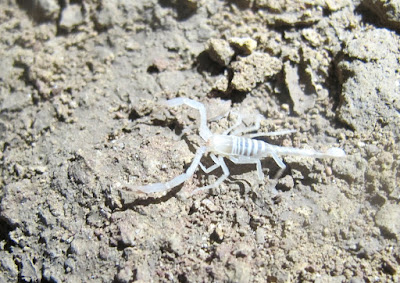[Most Recent Entries] [Calendar View]
Monday, August 13th, 2018
| Time | Event | ||||||
| 4:06p | [Crustacea • 2018] Aliaporcellana spongicola • A New Commensal Species of Aliaporcellana (Decapoda, Porcellanidae) from the western Pacific
Abstract Aliaporcellana spongicola sp. n. from the Philippines and Indonesia is described. The new species has been frequently photographed by divers because of its striking coloration, but has not been described yet. Aliaporcellana spongicola sp. n. is in fact a widespread commensal of barrel sponges of the genus Xestospongia and other sponges. Morphological characters and ecological information of all described species of Aliaporcellana, and of other porcellanids associated with sponges and soft corals, suggest that all members of the genus are commensals, and that similar morphological adaptations to dwelling on these hosts have evolved independently in different evolutionary lines within Porcellanidae. Keywords: Crustacea, Porcellanidae, Aliaporcellana, new species, Indo-West Pacific, commensalism, adaptation, sponge- and octocoral-dwelling Systematic account Family Porcellanidae Aliaporcellana spongicola sp. n. Description: Carapace rounded (Figures 1, 2), considerably variable in form and in length-width ratio; larger females with carapace broader than long (ratio < 1), smaller individuals with carapace relatively longer than broad (ratio > 1); dorsal surface convex, glossy, with faint, transverse striae on branchial and intestinal regions; cervical grooves gently depressed. Front (Figures 1, 2) broad, slightly produced beyond eyes, weakly trilobate, somewhat deflexed; frontal lobe visible in dorsal view, grooved, overreaching lateral ones. Distal margin of entire front lined with row of rounded, upwardly directed small spines (Figure 3a), the largest on supraocular edges. Outer orbital angles (Figure 2) forming acute, bifid tooth followed by hepatic spine of similar size. Epibranchial margin rounded, produced outwards, marked with epibranchial spine; cervical groove faintly marked. Mesial branchial margins crested, with row of 5 or 6 strong, anteriorly, upwardly directed spines of increasing size posteriorly. Sidewalls entire. Eyes moderately large (Figures 1, 2, 3a), retracted, ocular peduncles short. First movable segment of antennal peduncle (Figures 2, 3b) with strong, anteriorly curved distal spine, second with smaller, anterodistal, acute protuberance, third one globular. Basal segment of antennular peduncle (Figure 3c) with anterior surface transversely rugose, surrounded with open ring of strong, conical spines. Third maxilliped (Figure 3d) slightly rugose, ischium sub-quadrate with inner lobe, inner margin of merus semi-circular; exopodite long, pyriform, reaching 2/3 of length of merus.
Ecology: Aliaporcellana currently consists of six species. Of all species, A. spongicola sp. n. is by far the most strikingly colorful, and has, therefore, become popular among underwater photographers and marine aquarists. Aliaporcellana spongicola sp. n. dwells on large barrel sponges of the genus Xestospongia Laubenfels [family Petrosiidae; e.g., X. testudinaria (Lamarck 1815)] and on other types of sponges, like the “large, grey foliose sponge”, on which the crabs from Sulawesi included in this study, were found. The porcellanid lies in the sponge’s folds, where it is most protected from predators (Figure 5). Distribution: The type specimens come from the central Philippines and northern Sulawesi, Indonesia. Etymology: The name spongicola (from the Latin word spongia, meaning sponge, and the Latin suffix -cola, meaning dwelling) refers to the sponge-dwelling habit of the new species. Remarks: Aliaporcellana spongicola sp. n. is considerably variable in the shape of carapace and the degree of spination on body and extremities. As in other porcellanid species, the spines are more defined in smaller specimens. The new species is distinguished from A. pygmaea and A. kikuchii by the lack of acute spines on the dactylus of the smaller cheliped (Osawa 2007; Dong et al. 2011), and by its smoother surface of carapace and chelipeds (Lewinsohn 1969; Nakasone and Miyake 1969; Werding and Hiller 2007; Osawa and Chan 2010). Aliaporcellana spongicola sp. n. can be distinguished from A. suluensis, A. telestophila and A. taiwanensis by its regularly denticulated front (Figures 2, 3a), which is smooth in the other species, and by the basis of the antennular peduncle, which is crowned with a ring of spines (Figure 3c) and is at most granulate or faintly serrate in the compared species (see Lewinsohn 1969; Werding and Hiller 2007; Dong et al. 2011 for A. suluensis; Ng and Goh 1969 for A. telestophila; Dong et al. 2011 for A. taiwanensis). Alexandra Hiller and Bernd Werding. 2018. On A New Commensal Species of Aliaporcellana from the western Pacific (Crustacea, Decapoda, Porcellanidae). ZooKeys. 780: 1-9. DOI: 10.3897/zookeys.780.26388 | ||||||
| 4:27p | [Herpetology • 2018] Delineating Microhyla ornata (Anura, Microhylidae): Mitochondrial DNA Barcodes Resolve Century-old Taxonomic Misidentification
ABSTRACT Microhyla ornata, a species originally described from the southwest coast of India in 1841, was long reported to be wide-ranging throughout South, Southeast, and East Asia. Although the name M. ornata is restricted to populations from South Asia, the species is still considered to occur widely in India and its neighboring regions. To clarify the identity and geographical distribution of M. ‘ornata’, we performed DNA barcoding using a fragment of the mitochondrial 16S rRNA gene from 62 newly obtained samples. Our results show that this taxon is restricted to Peninsular India and Sri Lanka, whereas, populations from the other parts represent three different species – M. mukhlesuri, M. mymensinghensis, and M. nilphamariensis, creating new country records for India. Our work reemphasizes the benefits of DNA barcoding for rapidly identifying populations of widespread species and provides insights into the patterns of genetic differentiation in the M. ‘ornata’ species complex of South Asia. KEYWORDS: 16S; cryptic species; DNA barcoding; haplotype network; species distribution Microhyla mukhlesuri, M. mymensinghensis (Hasan et al. 2014), M. nilphamariensis (Howlader et al. 2015) Microhyla ornata (Duméril & Bibron, 1841) Sonali Garg, Abhijit Das, Rachunliu G. Kamei and S. D. Biju. 2018. Delineating Microhyla ornata (Anura, Microhylidae): Mitochondrial DNA Barcodes Resolve Century-old Taxonomic Misidentification. Mitochondrial DNA Part B. 3:2; 856-861. DOI: 10.1080/23802359.2018.1501286 Hasan M, Islam MM, Kuramoto M, Kurabayashi A, Sumida M. 2014. Description of two new species of Microhyla (Anura: Microhylidae) from Bangladesh. Zootaxa. 3755:401–418. DOI: 10.11646/zootaxa.3755.5.1 Mohammad Sajid Ali Howlader, Abhilash Nair, Sujith V. Gopalan and Juha Merilä. 2015. A new species of Microhyla (Anura: Microhylidae) from Nilphamari, Bangladesh. PloS ONE. 10:e0119825. DOI: 10.1371/journal.pone.0119825 | ||||||
| 5:08p | [Herpetology • 2018] Poyntonophrynus pachnodes • A New Earless Species of Poyntonophrynus (Anura, Bufonidae) from the Serra da Neve Inselberg, Namibe Province, Angola
Abstract African pygmy toads of the genus Poyntonophrynus are some of the least known species of African toads. The genus comprises ten recognized species endemic to sub-Saharan Africa, five of which are restricted to southwestern Africa. Recent field research in Angola provided new material for three species of Poyntonophrynus, including a morphologically distinctive population from the Serra da Neve Inselberg. Based on a combination of external morphology, high-resolution computed tomography scanning, and molecular phylogenetic analysis, the Serra da Neve population is described as new species that is nested within the genus. The most striking character that differentiates the newly described species from its congeners is the lack of a tympanic middle ear, a condition common in the family Bufonidae, but so far not known for Poyntonophrynus. The description of this new species from southwestern Angola reinforces the biogeographic importance of the region and further suggests that southwestern Africa is the cradle of diversity for this genus. Keywords: Africa, Amphibia, columella, osteology, toad
Poyntonophrynus pachnodes sp. n. Diagnosis: Poyntonophrynus pachnodes sp. n. is a small-bodied bufonid that lacks tarsal folds, a character that distinguishes it from bufonids in Angola except Mertensophryne and Poyntonophrynus. It differs from all Mertensophryne in having inconspicuous parotoid glands, compared to pronounced parotoid glands that form a shelf in the scapular region of Mertensophryne, and in lacking reduction of the phalanges (Grandison, 1981). The newly described species differs from all other members of the genus Poyntonophrynus in lacking a tympanum and columella.
Distribution and ecology: The species is currently only known from the Serra da Neve Inselberg (Figs 2, 8) in northern Namibe Province. Specimens were found on moist soil under rocks and leaf-litter at dusk in a semi-open miombo forest area. Grandvaux-Barbosa (1970) considered that Serra da Neve is characterized by a “sparse Miombo,” dominated by trees of the genera Julbernardia spp. and Brachystegia spp., and shrubs like Combretum spp. or Annona spp., which were observed at the site. The species was found sympatrically with the frogs Sclerophrys gutturalis and Tomopterna tuberculosa, the lizards Agama schacki, Trachylepis sulcata, Chondrodactylus pulitzerae, Hemidactylus benguellensis, Pachydactylus angolensis, and Heliobolus lugubris, and the snake Hemirhagerrhis viperina. Etymology: The specific name pachnodes (Gr.) means “frosty” and is used as an adjective (Brown 1954). This is a reference to both the cool climate at the higher elevation where this species occurs (1488 m) and that Serra da Neve (Port.) translates to “mountain of snow.” We suggest “Serra da Neve Pygmy Toad” and “Sapo Pigmeu da Serra da Neve” as the English and Portuguese common names respectively. Luis M. P. Ceríaco, Mariana P. Marques, Suzana Bandeira, Ishan Agarwal, Edward L. Stanley, Aaron M. Bauer, Mathew P. Heinicke and David C. Blackburn. 2018. A New Earless Species of Poyntonophrynus (Anura, Bufonidae) from the Serra da Neve Inselberg, Namibe Province, Angola. ZooKeys. 780: 109-136. DOI: 10.3897/zookeys.780.25859 | ||||||
| 5:15p | [Arachnida • 2018] The Genus Vietbocap (Scorpiones: Pseudochactidae) in the Thien Duong Cave, Vietnam: A Possible Case of Subterranean Speciation in Scorpions
Abstract Two new species of scorpion belonging to the family Pseudochactidae and to the genus Vietbocap are described based on specimens collected in the Thien Duong cave, which belongs to the Vom cave system, in the Phong Nha–Ke Bang National Park, Quang Binh Province, Vietnam. The previously described species from this cave, Vietbocap thienduongensis Lourenço & Pham, 2012 was collected in the initial section of the cave (1500 to 1800 m from the cave entrance) and proved to be a true troglobitic element. The diagnosis of this species, only known from males, is completed based on females collected at 750 m from the cave entrance. The two new species described here were collected respectively at 3000 and 5000 m from the cave entrance and are also true troglobitic elements, very similar to V. thienduongensis, but showing some clear morphological differences. This observed situation suggests a possible case of speciation within the cave system, the first one ever reported for scorpions. The population found at 5000 m from the entrance of the cave is a total new record of distance from a cave entrance for scorpions. Keywords: Scorpion; New species; Troglobitic element; Vietnam; Phong Nha–Ke Bang National Park; Thien Duong cave; Intra-cave speciation Family Pseudochactidae Gromov, 1998 Subfamily Vietbocapinae Lourenço, 2012 Genus Vietbocap Lourenço & Pham, 2010 Type: Vietbocap thienduongensis Lourenço & Pham, 2012 Vietbocap aurantiacus sp. n. Etymology. The specific name is a Latin adjective referring to the orange coloration of the new species (aurantiacus in Latin).
Vietbocap quinquemilia sp. n. Etymology. The specific name is a Latin noun in apposition referring to the distance from the cave entrance, 5000 m (quinquemilia in Latin) where the new species was found. Wilson R. Lourenço, Dinh-Sac Pham, Thi-Hang Tran and Thi-Hang Tran. 2018. The Genus Vietbocap Lourenço & Pham, 2010 in the Thien Duong Cave, Vietnam: A Possible Case of Subterranean Speciation in Scorpions (Scorpiones: Pseudochactidae). [Le genre Vietbocap Lourenço & Pham, 2010 dans la grotte Thien Duong, Vietnam : un cas possible de spéciation souterraine chez les scorpions (Scorpiones : Pseudochactidae)] Comptes Rendus Biologies. 341(4); 264-273. DOI: 10.1016/j.crvi.2018.03.002 Résumé: Deux nouvelles espèces de scorpion appartenant à la famille des Pseudochactidae et au genre Vietbocap sont décrites à partir d’exemplaires collectés dans la grotte Thien Duong, laquelle appartient au système des grottes Vom dans le parc national Phong Nha–Ke Bang dans la province de Quang Binh, Vietnam. La seule espèce déjà décrite de cette grotte, Vietbocap thienduongensis Lourenço & Pham, 2012, a été collectée dans la partie initiale de celle-ci (entre 1500 et 1800 mètres de l’entrée) et a été confirmée comme un véritable élément troglobie. La diagnose de cette espèce, connue uniquement à partir des mâles, est complétée à partir de femelles collectées à 750 m de l’entrée de la grotte. Les deux nouvelles espèces décrites à présent ont été collectées respectivement à 3000 et 5000 m de l’entrée de la grotte et sont également des éléments troglobies, plutôt similaires à V. thienduongensis, mais avec des différences morphologiques bien nettes. La situation observée suggère un possible cas de spéciation à l’intérieur de la grotte, le premier signalé chez les scorpions. La population trouvée à 5000 m de l’entrée de la grotte représente un record absolu de distance de l’entrée d’une grotte pour des scorpions. Mots clés: Scorpion; Nouvelle espèce; Troglobie; Vietnam; Phong Nha–Ke Bang National Park; Grotte Thien Duong |
| << Previous Day |
2018/08/13 [Calendar] |
Next Day >> |





















